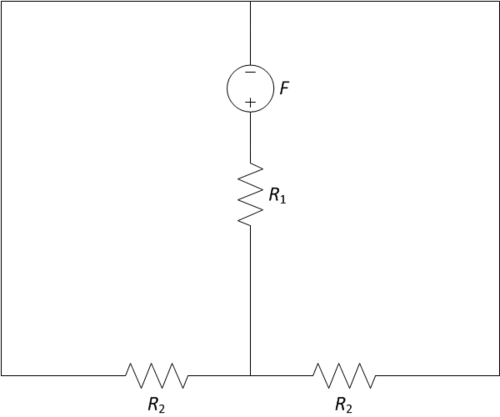Answers and Discussions for
Contents
Problem 1
Create and Solve Magnetic Equivalent Circuit
A magnetic equivalent circuit (MEC) needs to be constructed from the given plunger geometry. A magnetomotive force of $ \mathcal{F} = Ni $ acts as an analogue of a DC voltage source. In general, a reluctance may be expressed as $ \mathcal{R} = \frac{\ell}{\mu A} $ and function as a resistance analogue. If the steel is infinitely permeable, then the reluctance associated with a path through steel is zero (ideal conductor equivalent). In this problem, the permeability of air (linear, isotropic, and homogeneous) is approximated as free space: $ \mu_{\text{air}} = \mu_{r,\text{air}} \mu_0 \approx \mu_0 $. Without any fringing or leakage considered, magnetic flux $ \Phi $ will more or less follow the direction of the steel.
The reluctances need to be calculated using the length and cross sectional area presented to each path in air.
- $ \mathcal{R}_1(g) = \frac{g}{\mu_0 w d} $
- $ \mathcal{R}_2 = \frac{c}{\mu_0 t d} $
The total magnetic flux passing through $ \mathcal{F} $ needs to be found. It should be apparent that $ \mathcal{R}_1 $ is in series with the parallel combination of $ \mathcal{R}_2 $ and $ \mathcal{R}_2 $.
$ \begin{align} \Phi_1(i,g) &= \frac{\mathcal{F}}{\mathcal{R}_{eq}} \\ \Phi_1(i,g) &= \frac{Ni}{\mathcal{R}_1 + \frac{1}{2}\mathcal{R}_2} \\ \Phi_1(i,g) &= \frac{Ni}{\frac{g}{\mu_0 w d} + \frac{c}{2\mu_0 t d}} \\ \Phi_1(i,g) &= \frac{Ni}{\frac{2 t g}{2\mu_0 w t d} + \frac{w c}{2\mu_0 w t d}} \\ \Phi_1(i,g) &= \frac{2N \mu_0 w t d i}{2 t g + w c} \end{align} $
The magnetic flux linkage of the coil follows readily.
$ \begin{align} \lambda_1(i,g) &= N \Phi_1(i,g) \\ \lambda_1(i,g) &= \frac{2N^2 \mu_0 w t d i}{2 t g + w c} \end{align} $
Coenergy Calculation
Coenergy will be calculated in steps using a sequential ramping process. Before any steps can be completed, the contribution to coenergy of fixing the mechanical system should be documented (zero unless the mechanical system can store energy itself by moving from one position to another).
$ \begin{equation} W_{c,0} = 0 \end{equation} $
The first step in the coenergy calculation will ramp dummy variable $ i_1' $ from $ 0 $ to its final value of $ i $.
$ \begin{align} W_{c,1} &= \int_{i_1' = 0}^{i} \lambda_1\left(i_1', g\right) \, di_1' \\ W_{c,1} &= \int_{i_1' = 0}^{i} \frac{2N^2 \mu_0 w t d \cdot i_1'}{2 t g + w c} \, di_1' \\ W_{c,1} &= \frac{N^2 \mu_0 w t d \cdot i^2}{2 t g + w c} - 0 \end{align} $
The final step is the sum all the individual coenergy contributions $ W_c(i, g) = \sum_{k = 0}^{1} W_{c,k}(i, g) $.
$ \begin{align} W_c(i, g) &= W_{c,0} + W_{c,1} \\ W_c(i, g) &= 0 + \frac{N^2 \mu_0 w t d \cdot i^2}{2 t g + w c} \\ W_c(i, g) &= \frac{N^2 \mu_0 w t d i^2}{2 t g + w c} \end{align} $
This calculation is consistent with the known result of a magnetically linear system having a coenergy of $ W_c(i, g) = \frac{1}{2} L_1(g) i^2 = \frac{1}{2} \lambda_1(i, g) i $.
Electromechanical Force Calculation
Electromechanical force is just the partial derivative of coenergy with respect to mechanical position, the variable $ g $ in this problem.
$ \begin{align} f_e &= \frac{\partial W_c(i, g)}{\partial g} \\ f_e &= \frac{N^2 \mu_0 w t d i^2}{\left(2 t g + w c\right)^2} \cdot -2t \end{align} $
Recall by the Quotient Rule or the Chain Rule + Power Rule that $ \frac{d}{dx} \frac{a}{bx + c} = \frac{-ab}{(bx + c)^2} $ for $ a,b,c \in \mathbb{R} $. Thus, the electromechanical force equation is obtained for this device.
$ \begin{equation} \boxed{T_e = \frac{-2 N^2 \mu_0 w t^2 d i^2}{\left(2 t g + w c\right)^2}} \end{equation} $


